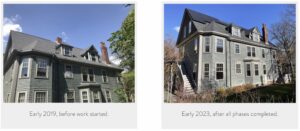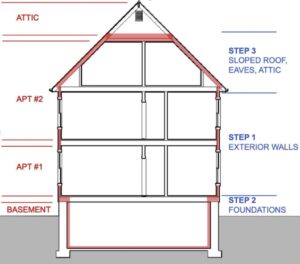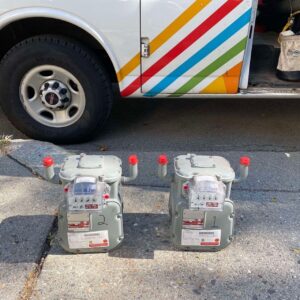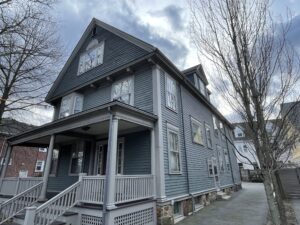125 Years Young: An Electrification Story
May 2025By Brendan Kavanagh
Diane and Randolph are architects and passionate climate activists who worked with us to electrify their 1890s Brookline duplex in phases between 2019 and early 2023. To commemorate their achievement, they placed a vintage “Live Better Electrically” medallion from a 1950s home electrification program by their front door. It is a perfect symbol of the pride they take in both electrification and preservation.
First, a Bit of Background
In 2019, they started off by re-roofing and installing 21 solar panels across the south side. They put up as much as they could at the time to prepare for future electrification. Next, they worked with MassSave to insulate their exterior walls with dense-packed cellulose. The old walls had a back-plaster layer in them, which made getting them insulated more challenging, but determination and persistence won out in the end.

Phase 1
Byggmeister started our first phase of work in 2021. Picking up where MassSave left off, we focused on improving the top and bottom of the building envelope. In the basement, we insulated the fieldstone foundation walls with spray foam and installed new windows. Their unusually high basement ceilings allowed us to also lay down foam board insulation and painted subfloor panels over the existing slab. On the top floor, we removed one unused chimney down to below the third floor and insulated the roofline from the exterior walls up to the vented attic cap.

The insulation and air sealing work done by MassSave and our Phase 1 project gave this building a more continuous insulation layer and reduced the air leakage from around 16 ACH50 to 9.5 ACH50—a roughly 40% improvement. While not all the way up to modern new construction standards, this was a huge improvement and crucial in easing the transition from big gas boilers to high-efficiency heat pumps.

During this first phase of work, we also removed the old radiators from the third floor and installed a ducted heat pump system and an Energy Recovery Ventilator (ERV) just for the top floor. Previously, Diane had preferred sleeping with a window cracked whenever possible. The addition of the ERV helped mitigate the stuffiness that affected Diane’s sleep and the energy penalty from cracking a window at the top of the building all year long.
After Phase 1, Diane and Randolph took a break to resettle back into their home. During that time, their home’s natural gas usage was almost half of what it had been. Their electricity use was up slightly (not including solar production), but combined with the gas savings, they were using over 40% less total energy than before. It wasn’t long before they felt ready to keep going and finish what they started.
Phase 2
Next, we focused on getting rid of the remaining natural gas, which included their boilers, water heater, cooking, and clothes drying. We replaced those with more heat pump systems, a heat pump water heater, induction ranges, and electric dryers. Our Phase 1 building envelope improvements helped us use smaller heat pump systems, which helped us avoid increasing the existing 200-amp electrical service.

They were able to have both natural gas meters removed, and after Phase 2 work, their annual energy consumption dropped another 35%. This now all-electric home uses 75% less energy than it did before 2019, and their solar panels produce almost half of what they use each year. As the electric grid continues to shift towards more renewables over time, this home’s carbon footprint will get smaller and smaller.

Both gas meters celebrating their retirement!
Post-Project Check-In
When we spoke with Diane and Randolph in March of 2025, it had been just over two years since we finished work on-site. We asked them what they enjoyed, found challenging, and were surprised by when reflecting on their electrification journey.

March 2023, after phase 2.
The first thing they mentioned was how much more comfortable and clean their home is now. They used to have windows open often to be comfortable, which let in a ton of dust and pollen—“tree stuff from the back, truck stuff from the front,” as Randolph put it. While they do still open their windows occasionally in the spring and fall, it’s much less than before, and they love how much less cleaning they need to do. This was most noticeable in the basement, which in Diane’s words went from being “disgusting and musty” to “dry and cool.” Randolph has a workshop down there, which he did not expect to be as clean and comfortable as it is.
The primary challenges they experienced were the high upfront cost, the disruption, and the technical complexity. We were able to mitigate the cost somewhat by leveraging utility rebates and financing, primarily through MassSave. Diane and Randolph also think about the improvements as an investment in their home, which they intend to stay in for the long term. That investment benefits them now by improving their comfort and reducing their energy bills, and in the longer term, it significantly reduces carbon emissions and makes the home less susceptible to being torn down. While the disruption of moving their belongings out of and back into work areas was a challenge, it also gave them an opportunity to purge and reorganize. Lastly, the technical information was challenging even for them despite their background as architects and made them “so glad that Byggmeister was there.”
What surprised them the most was how much they’ve enjoyed forced air heating and cooling, as Randolph had worried about moving away from their existing cast iron radiators. Having experienced discomfort with high-velocity forced air systems in other buildings, he was relieved that this was not the case with their ducted heat pumps. In fact, he said he barely notices when the heat pumps are running because they operate at such low speeds.
We learned a lot from chatting with Diane and Randolph about their experience electrifying their home and living in it since. We are proud to have helped them accomplish their goals and are happy that they are happy. Stories like theirs are hugely helpful in building confidence that electrification of our existing homes can be done in a variety of ways, which often improve a lot more than just your energy bills.